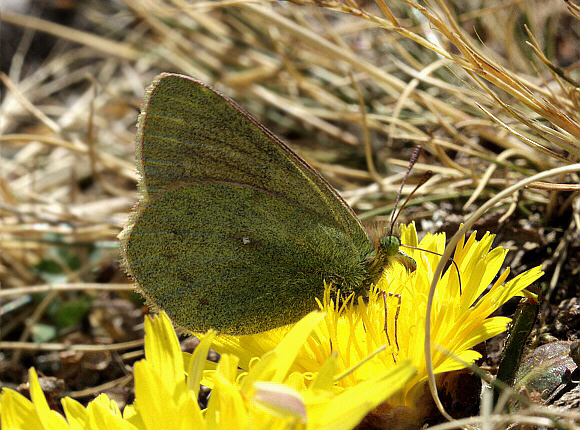
Introduction
Members of the subfamily Coliadinae, commonly known as Brimstones, Sulphurs, Grass Yellows and Clouded Yellows, are found in all regions of the world, and total about 300 species. The majority are migratory in behaviour – Colias crocea for example migrates every summer from north Africa to England, and Phoebis agarithe migrates seasonally from the Amazon lowlands to moderate altitudes in the Andes.
Colias flaveola is one of several Clouded Yellow species which breed at high altitudes in the Andes. It has evolved 6 subspecies, probably due to isolation during periods of glaciation. These subspecies include erika – a well marked pale primrose-yellow race, and the dark and indistinctly marked mossi and weberbaueri. Males of the latter are very heavily marked, with no trace of pale areas on either surface of the forewings. Females are paler, with the basal two-thirds of the forewings off-white, and the hindwings pale greenish yellow on the underside.
Colias flaveola occurs in Peru, Bolivia, Chile and Argentina. The illustrated subspecies weberbaueri is restricted to the high Andes of Peru and Bolivia.
Habitats
This species breeds on dry puna grasslands and lightly grazed pastures at elevations between 2800-4000 metres, in areas bathed in the warm sunshine above the cloud line for most of the year.
Lifecycle
The early stages appear to be undescribed, but the following characteristics are typical of the genus Colias, and therefore probably apply to flaveola :
The eggs are bottle-shaped, ribbed vertically, in most species are creamy yellow or pale green when first laid, but later turn orange or dark crimson. They are nearly always laid singly, on the leaves of the larval foodplants.
The caterpillars are typically green, with a white or yellow lateral line that is sometimes edged with by a series or black or pinkish dashes. The spiracles are usually highlighted in yellow or orange.
The larval foodplants of Colias species are varied, North American Colias species for example feed on plants including Leguminous herbs such as Lotus, Vicia, Trifolium and Astragalus, and on dwarf sallows Salix, and bilberry Vaccinium. The pabula used by most neotropical species are unknown.
The chrysalis is usually green or straw coloured, and fixed vertically to a stem by the cremaster and a silken girdle.
Adult behaviour
Migrating adults fly rapidly across the Andean grasslands, stopping momentarily to nectar at any available flowers, and often patrolling back and forth along ridges.
